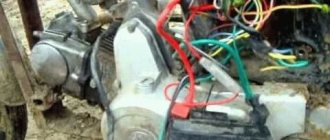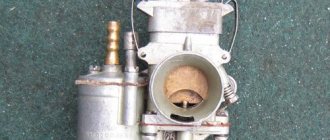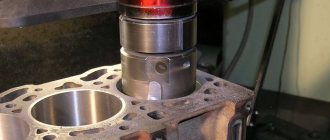This article is intended for beginners. It makes sense to check the condition of the spark plug when the engine is unstable, hard to start, or consumes a lot of fuel. By the appearance of the spark plug, you can determine whether the settings of the fuel system, in particular the carburetor, are correct. If the check shows that the spark plug is heavily soiled or damaged, it should be replaced. Fortunately, candles are very inexpensive. How to choose a spark plug for a scooter and what the alphanumeric values in its marking mean can be read here.
To do this job, we will need a 10mm socket wrench, as well as a 21mm spark plug wrench or spark plug socket.
So we need to get to the spark plug. Fortunately, access is very easy.
First you need to open the seat and use a 10mm wrench to unscrew the 4 bolts securing the seat to the frame. For a Honda Tact scooter, you will need to unscrew and remove the oil tank cap. After unscrewing the bolts, remove the seat.
Now, turning the spark plug head left and right, we pull it off the spark plug.
After that, take the spark plug wrench and place it on the spark plug. It may turn out that the spark plug wrench is too long and it rests on the frame, making it impossible to put it on the spark plug. This was the case in my case. Therefore, instead of a spark plug wrench, I just took a 21 socket and an adjustable wrench. Unscrew the spark plug counterclockwise.
That's all. Now you can evaluate the appearance of the candle and, if necessary, replace it with a new one, proceeding in the reverse order.
Please note: This article and the images in it are subject to copyright. Partial or complete reproduction on other resources without permission is prohibited.
When servicing a scooter, it is necessary to unscrew the scooter's spark plug to determine whether the carburetor is set correctly. It is important to pay attention to the brand and heat rating of the spark plug - if you install a spark plug with a different heat rating from the recommended one, it will not self-clean. If the candle is whitish, you need to enrich the mixture; if it is black, lean it. The adjustment is made on the scooter's carburetor with a special screw located under the cover covering the accelerator drive rocker arm. It is important to remember that a scooter air filter clogged with dirt, without passing the required amount of air, will cause the mixture to become richer, and before drawing conclusions about the need to adjust the scooter carburetor, it is necessary to check the condition of the air filter. A correctly selected scooter spark plug has a decisive influence on the performance of the scooter, as well as on its temperature regime. A spark plug with the heat rating recommended by the manufacturer should be installed on the engine only; only in this case will the process of self-cleaning from carbon deposits occur.
Soot contamination
Type of spark plug: dry soft soot of intense black color on the insulator, electrodes and spark plug body.
Consequences: poor start of the scooter engine; poor operation of a cold scooter engine; interruptions in ignition of the air-fuel mixture; bad reaction to gas.
Probable causes: excessively rich air-fuel mixture; The scooter's air filter is very clogged; The thermal range is incorrectly selected - the candle is too “cold”.
Remedy: adjust the working mixture; adjust the cold start system of the scooter engine; change the scooter air filter; clean the spark plugs or replace them with new ones - with the correct heat rating.
How to replace a spark plug on a scooter
Checking the spark plugs is advisable when the engine operation is unstable - the scooter does not start well or begins to consume a lot of gasoline. By the appearance of the spark plugs, you can determine whether the fuel system is configured correctly or not, in particular, we are talking about the carburetor.
Attention!
If the diagnosis reveals that the spark plug is heavily soiled or damaged, it must be replaced. This item is inexpensive.
This process may seem simple, but in fact there are some nuances. So, if you don’t know them, there is a risk of breaking the thread in the spark plug hole. It is especially difficult for beginners, so it is important to listen to the recommendations of experts.
To make the replacement, you will need a 10mm socket wrench and a 21mm spark plug wrench or spark plug head. It is not difficult to get to the spark plug.
Replacement algorithm:
- Open the seat.
- Using a 10mm wrench, unscrew the 4 bolts securing the seat to the frame.
- Remove the seat.
- Pull the spark plug head off the spark plug by twisting it left and right.
- Place the spark plug wrench on the spark plug. If the spark plug wrench is very long and rests against the frame, then it will not be possible to put it on the element that requires replacement. Therefore, it is advisable to replace the spark plug wrench with a 21 socket and an adjustable wrench.
- Unscrew the spark plug counterclockwise.
Then you need to inspect the spark plug and replace it if necessary. In this case, the algorithm is reversed.
Overheat.
Plug Type: Extremely white insulator with small black flecks and premature electrode erosion.
Consequences: loss of scooter power at high speed or under load.
Probable causes: the spark plug is not screwed in enough; The scooter's engine cooling system is not working properly; ignition of the scooter too early; The thermal range is incorrectly selected - the candle is too “hot”.
Remedy: check the torque of the scooter's spark plug; operation of the scooter engine cooling system; adjust the ignition timing; select the correct spark plug heat rating.
Type of spark plug: melted and burned central and grounding electrodes (or one of the electrodes) of the scooter spark plug; bubbling insulator with metal deposits on it.
How to start the engine
If yesterday the scooter was working as usual, but today it doesn’t even start, then most likely the reason for this is hidden in the spark plugs. New owners of such a vehicle do not know how to start the engine. There are two ways to solve this problem. First: take out and dry the candles. But if there is not enough time, then the second option is also suitable: initially you need to leave the scooter for 5 minutes. After this, completely unscrew the throttle and turn the starter. Continue for approximately 15 seconds. At this time, the fuel supply to the chamber will stop and it will be purged with air. This should be enough to start the engine. This method is suitable for those who have a 4T Chinese scooter and who are wondering what to do with a 2T scooter.
If this method does not work, you can try drying the candles. To do this, you need to unscrew these elements, clean the carbon deposits with a brush, and dry them with a hairdryer in the oven or on the stove. When screwing the spark plugs into place, you need to control the gap. After this, the engine should start.
Attention!
If the vehicle is not new, then the spark plugs need to be cleaned more often, or better yet, replaced.
If the spark plugs are constantly filled with gasoline, then diagnostics are required. The spark plugs must be checked for spark quality, the cleanliness of the injectors, and the spark output from the ignition coils must be diagnosed. The Hall sensor is also subject to testing.
Oil contamination
Type of spark plug: wet oily black deposits on the insulator, black oil deposits on the insulator, electrodes and spark plug body.
Consequences: poor start of the scooter engine, interruptions in ignition.
Probable causes: too much oil in the fuel mixture (for two-stroke engines); wear of the rings and/or piston liner - wastes oil.
Remedy: mix gasoline and oil in the correct proportion, install new spark plugs for the scooter (for two-stroke engines); inspect the condition of the scooter engine, if necessary, repair the engine, CPG; .
Solutions to the problem
Initially, you need to understand what exactly the problem is, and then decide how to repair it. If the cause is found, then other problems should not be ruled out, since there may be a connection between them. Need to:
- Check battery charge. In winter and autumn it must always be charged, since the power of the spark also depends on this factor. This is primarily important for old vehicles - their battery life has already been partially exhausted.
- Check the quality of the fuel. You should only refuel at proven gas stations. When using low-quality fuel, the scooter may stall or not start at all at the most inopportune moment.
- Choose the right oil. Much also depends on its viscosity and quality. For cold weather, winter fuels and lubricants must be used.
- Check that the valves are correctly adjusted on a scooter with a 4t engine. If mistakes are made, fuel will enter the chamber at the wrong time and will not ignite.
- Check the air filter as it may need to be replaced or cleaned.
- Adjust the carburetor screw and the quality of the mixture if gasoline is supplied through it.
- Make sure the spark plug is working correctly. If necessary, adjust the gap between the electrodes, replace the spark plug or ignition coil.
Attention!
If the spark plug is flooded, you need to load the engine at high speeds at least once a week. In this way, you can blow out the cylinder and spark plugs from accumulated carbon deposits.
If you have doubts about your own abilities, then you should turn to specialists.
Causes of malfunction
Due to a flooded spark plug, the scooter may not start at all or may be unstable. So, what could be the reason:
- Clogged air filter. Insufficient air supplied to the carburetor enriches the fuel mixture. As a result, a large volume of fuel does not have time to burn in the chamber, and the spark plug becomes dirty.
- Incorrect carburetor adjustment. A tightened mixture quality screw on the carburetor has almost the same effect as a clogged air filter.
- Faulty ignition system. There are several faults at this point: faulty spark plugs - bad wires - problems with the ignition coil - incorrect timing (on old equipment, for example).
- Poor quality fuel. Gasoline diluted with another liquid greatly affects the contamination of the spark plug.
Oddly enough, the spark plug on the injector can also flood. This usually happens in winter on worn-out engines. Since the quality of the mixture is regulated by an electronic control unit (ECU), it would seem that the spark plugs should not be flooded.
This is what a lit candle usually looks like
However, poor compression, a discharged battery, a bad starter, an insufficiently powerful spark and incorrect electrode gaps do not allow the scooter to start at subzero temperatures. In cold weather, the ECU supplies more fuel to the cylinder, since cold air contains more oxygen than hot air.
For a number of reasons described above, the scooter does not start and the spark plug is flooded.
What does the ignition system consist of?
Such a system on a scooter includes the following devices:
- battery
- starter
- current generator
- switch
- coil
- lock
- candle
- wiring.
Although all these elements have different sizes, costs and complexity of the device, their importance in the proper operation of motorcycle equipment is almost equal. The malfunction of just one of the above elements leads to a malfunction of the entire scooter.
Each of these devices has its own possible malfunctions. Let's discuss each device in order in which repairs should be made.
Spark plug
The most common breakdown in the ignition system (including why there is no spark on a scooter) is a faulty spark plug. The reasons are completely different: carbon deposits due to poor fuel quality (or oil); overheat; lean or enriched air-fuel mixture and others.
The candle should be clean, without much carbon deposits, brick color
You can assess its condition visually by unscrewing it from the cylinder. The working color of the candle is brick. But white and black indicate problems in her work. The best way to solve the problem is to replace it with a new one. If this is not possible, then clean it with a brush, rags or heat it on a gas burner.
The spark test is carried out in the following order:
- The spark plug is unscrewed from the cylinder along with the tip.
- The spark plug body is leaned against a metal “mass”.
- The engine rotates with the crank or starter, and sparks should jump between the electrodes of the spark plug.
To check the spark plug, lean it against the metal body of the scooter.
Remember! If a spark appears during replacement, then the ignition system is in order and you should move on to diagnosing other parts of the scooter.
Ignition coil
If the spark plug is replaced with a new one, but the scooter (moped) still does not start, we diagnose the coil. The coil is a device with two windings - primary and secondary. Visually, it is a barrel with two contacts and a high-voltage wire coming out.
Scooter coil
The role of the coil is to increase the incoming voltage hundreds of times. The primary winding has two contacts as outputs. The secondary winding is located between the positive contact and the end of the high-voltage wire. Violation of the integrity of one of the windings leads to failure of the main task and, as a result, the absence of a spark.
Moped reel
It is better to start diagnosing the coil with the spark plug cap. Inside the cap there is an interference suppression resistor, which also fails. You can check it with a multimeter in resistance measurement mode. You need to connect probes to the unscrewed cap - one to the spark plug seat, the other to the end for the armor wire. The resistance is considered normal - within 5 kOhm. If not correct, replace the cap.
How to check the spark?
We insert the spark plug into the spark plug cap and place the spark plug on the engine so that its metal base touches any metal part of the engine. Turn on the ignition, press the start button or kickstarter foot and look at the spark plug electrodes.
- If there is a spark between the electrodes, the spark plug is working
- If there is no spark between the electrodes, the spark plug is broken; to be sure of this, try a known good spark plug or a new spark plug.
- If there is no spark and there is a working spark plug, the spark plug has nothing to do with it and the problem is not in it, but for example in the coil, switch or generator
Scooter Sym Orbit 50
Sym Orbit 50 scooter user manual
Technical characteristics of the Sym Orbit 50 scooter
| Dimensions (l/w/h) | 1905/690/1125 mm |
| Wheelbase | 1327 mm |
| Weight | 99 kg |
| Engine | four-stroke |
| Engine capacity | 49.5 cm3 |
| Maximum power | 2.35 kw / 8500 rpm |
| Cooling system | air |
| Engine starting | Electric starter, kick starter |
| Front suspension | telescopic fork |
| Rear suspension | swing system |
| Transmission | variable speed drive |
| Clutch | centrifugal type |
| Tire (front/rear) | 20/70-12 |
| Brakes (front/rear) | drum type |
| Oil volume in crankcase | 0.85 l |
| Transmission oil volume | 1.1 l |
| Gas tank volume | 5.2 l |
| Candles | TORCH A7RC |
| Battery | 12V 6Ah |
| Air purifier | paper type |
To make your scooter ride comfortable, it is very important to choose the right clothes.
1. Be sure to put on a helmet before driving. 2. Outerwear should have tight-fitting sleeves or cuffs. 3. When riding a scooter, it is better to wear a tight-fitting jacket and trousers or overalls. 4. It is advisable that your clothes be bright. This will increase your safety on the road. 5. Outerwear should be comfortable and not restrict your movements.
Starting the engine with an electric starter.
- Place the scooter on the center stand.
- Press and hold either brake lever.
- Set the main switch to the “ON” position.
- Press the electric starter button without rotating the throttle.
- Once the engine starts, release the starter button.
- If the engine is cold, run it for a while to warm it up.
ATTENTION! 1. Immediately release the starter button after starting the scooter. 2. Do not press the starter button after the engine has started. 3. If the engine is hot and does not start when you press the starter button for 3-4 seconds, then turn the throttle handle (gas handle) 1/8 turn and press the starter button again. 4. To avoid discharging the battery, do not hold the starter button pressed for more than 10 seconds. If the engine does not start after pressing the starter button for 10 seconds, wait 10 seconds and try to start the engine again.
Start of movement
- To remove the scooter from the center stand, it is necessary. Hold the left brake handle and push the scooter slightly forward. You should stand to the left of the scooter.
- You should sit on the left side. You should sit upright in the seat with one or both feet remaining on the ground.
- Release the rear brake lever and begin to slowly rotate the throttle grip (throttle grip).
ATTENTION! Do not turn the throttle sharply to avoid the scooter lifting onto its rear wheel and tipping over. This is especially dangerous when driving uphill or with a significant load on the trunk. Before entering the road, use the appropriate turn signal to alert other drivers of your intention. Before starting to move from the sidewalk, look carefully to the left and behind to make sure that your maneuver is safe.
Stop
When approaching the place where you want to stop, do the following: 1. Turn on the correct turn signal and, making sure that you are not interfering with other vehicles, slowly turn to the place where you want to stop. 2. Allow the throttle to rotate in the opposite direction to its original position. Then, by pressing the front and rear brake levers, bring the scooter to a complete stop. The illuminated brake light will alert drivers behind you that you are about to stop. 3. After the scooter has come to a complete stop, turn the turn switch to the center position and the ignition key to the “OFF” position. 4. Make sure that you park the scooter in a place where it will not interfere with traffic. Remember that the scooter may tip over if the center stand is not placed on a firm, level surface. 5. To place the scooter on the center stand, grasp the handlebars with your left hand and, with your right hand on the rear trunk, step on the center stand with your right foot. While in this position, lift the rear of the scooter up to lock the center stand.
ATTENTION! To prevent your scooter from being stolen, be sure to lock the steering wheel and remove the key from the ignition while parking.
Recommendations for driving a scooter
- Never press the brake lever sharply or turn the steering wheel suddenly to the side. Sudden braking or turning the steering wheel can cause the scooter to skid or overturn.
- When driving in rainy weather, you need to be especially careful. Do not apply sudden braking on wet roads, as this may cause the scooter to skid.
- When driving on wet roads or in rainy weather, more braking distance is required. Reduce speed and start braking earlier than necessary on dry roads.
- When cornering, do not suddenly release the gas or brake, as this can lead to loss of control and a fall. The turn should be made “tightly”, controlling the throttle, or slow down in advance.
- Remember that when driving through water or in rainy weather, the brake pads get wet, which leads to poor braking performance.
Instruments and indicators
On the dashboard there are:
1.Fuel Pressure Gauge - Indicates the level of gasoline in the fuel tank 2.Turn Signal Indicator - When the turn signal is turned on, this indicator will flash 3.High Beam Indicator - Indicates that the high beams are on 4.Speedometer - Indicates the driving speed. 5.Odometer - Indicates the total distance traveled by the vehicle.
Egnition lock
Position "Start" In this position the engine starts. The key cannot be deleted at this position.
Stop position The engine is switched off and cannot be started. The ignition key can be removed.
OPEN position: Opening: Insert the key into the ignition and turn it to the left. Locking: press the glove compartment lid, locking occurs automatically.
“Steering handle lock” position Turn the key to the “LOCK” position. The steering wheel is locked in this position. The ignition key can be removed. You can unlock the steering wheel by turning the key from the “LOCK” position to the “OFF” position.
ATTENTION!
1.Never turn the key while the scooter is moving. Turning the ignition key to the "OFF" and "LOCK" positions will shut down the electrical system, which may result in an accident. The ignition can only be turned off after the scooter has been completely stopped. 2.Always remove the ignition key, and make sure to remove the ignition key after locking the steering wheel for parking. 3.If the ignition key is left in the "ON" position for a long period after stopping the engine, it will drain the battery.
Purpose of switches
Headlight switch
When the switch is in this position, the headlight, dimensions and instrument panel lighting are turned on.
When the switch is in this position, the headlight, dimensions and instrument panel lighting are turned on.
When the switch is in this position, the headlight, side lights and instrument panel are turned off
Starter button
When you press this button, the engine starts.
ATTENTION !
Immediately release the starter button after the engine starts
Do not press the starter button after the engine has started.
Do not keep the starter button pressed for more than 10 seconds to avoid draining the battery.
Horn button
Pressing this button will sound an alarm when the ignition key is in the "ON" position.
Turn signal switch
When this switch is turned on while the ignition key is in the "ON" position, the turn signal will flash:
this switch position means making a right turn.
This switch position means making a left turn.
Switch for low and high beam
This switch is used when it is necessary to turn on the low or high beam while driving a scooter.
This is the switch position for high beam
This is the switch position for low beam
Brake
- Avoid sudden hard braking.
- Use the front and rear brakes at the same time.
- Avoid continuously applying the brakes for long periods of time as this may overheat the brakes and reduce braking effectiveness.
- When driving on wet and slippery roads, drive slowly and brake smoothly. Never apply the brakes suddenly to prevent slipping and falling.
- Using only the front brake will increase the risk of falling as the scooter tends to skid sideways.
Parking
■ When approaching a parking lot: 1. Turn on your turn signal in advance and pay attention to vehicles in front and behind, left and right, then select a route and proceed slowly along it. 2. Release the gas and apply the brakes early. (The brake light illuminates when braking to warn drivers of vehicles behind.) ■ When parking: 1. Turn off the turn signal, turn the ignition key to stop the engine. 2. Get off the scooter on the left side after the engine has been stopped, select a flat piece of ground, then place the scooter on the center stand. 3. Grab the handlebars with your left hand and grab the mount on the lower left side of the saddle with your right hand. 4. Press your right foot on the center stand, pull the scooter back with your hands
We remind you : Lock the steering wheel and remove the key after locking to prevent the scooter from being stolen.
WARNING: • Park your scooter in a safe place where it will not interfere with traffic.
Before you start driving:
■ Turn on your turn signal before driving and make sure there are no vehicles behind you. After that, start moving. ■ When starting the engine, keep a close eye on vehicles ahead and behind you.
Speed control
The speed is controlled using the throttle grip
- If you turn the throttle handle (towards you), the speed of the scooter increases.
- Please rotate the throttle slowly to avoid the scooter from tipping over.
- When driving uphill, turn the throttle further to increase engine power.
- If you rotate the throttle in the opposite direction (away from you), the speed of the scooter will decrease. This can be done slowly or quickly, depending on how quickly you want to slow down.
Drum brake adjustment
The free play of the brake lever should be 10-20 mm.
1) To increase the free play of the brake lever, rotate the adjusting nut counterclockwise. 2) To reduce the free play of the brake lever, rotate the adjusting nut clockwise.
Oil check
In order to check the engine oil, you must: 1) Place the scooter on the center stand.
2) Allow the engine to cool for 2-3 minutes.
3) Remove the oil dipstick and wipe it with a cloth.
4)Insert the oil dipstick into the hole to check the oil level.
5) Remove the oil dipstick and visually determine the oil level in the engine.
6) The oil level should be between the upper and lower marks of the oil dipstick.
Change of oil
To change the oil, you must:
- Warm up the engine and place the scooter on the center stand.
- Allow the engine to cool.
- Unscrew the control bolt and remove the oil filter.
- Drain the oil.
- Clean the oil filter using gasoline and blow it with air pressure.
- Insert the oil filter and tighten the control bolt.
- Pour oil through the oil fill hole.
- Check the filled oil level with a dipstick.
Tire check
Before driving, visually check the condition of the tires. If you notice a change in the shape of your tires in relation to the area in contact with the ground, check the tire pressure using an air pressure gauge and adjust it to the appropriate level.
- Visually check the tread and sidewalls of the tire for cracks and damage.
- Visually check the tread and sidewalls of the tires for nails, stones or other objects that may be stuck in the tire.
- Visually check for a wear indicator on the tire tread. If you do not see the indicator, the tire should be replaced with a new one.
Battery
If the battery terminals are dirty or rusty, remove the battery from the scooter and clean the terminal block with a wire brush. When checking and cleaning the battery, make sure there is no open flame nearby. Before removing the terminals from the battery, turn the ignition key to the “OFF” position.
Inspection of front shock absorbers
1. Carry out this test with the ignition off and without the key in the ignition. 2, Visually check the front shock absorbers for mechanical damage 3, Grab the steering wheel, move up and down - listen for any extraneous noise 4, Check the fastenings of the front shock absorbers 5, Grab the steering wheel, push forward and backward, left and right, determine the strong or low shock absorber resistance and any dips 6,Check the brakes for tension in the brake cables 7,If any of the above faults are found, take your scooter to an authorized SYM dealer for inspection and repair.
Checking and replacing fuses
- Turn off the ignition and check the fuses. If the fuse is blown, replace it with a new one with the same marking (7A). It is strictly prohibited to use a fuse larger than 7 A or a wire to replace the fuse when replacing, as this may damage the electrical system.
- Open the glove box, there is a fuse box at the top right.
- Open the fuse cover and remove the fuse. Check it for malfunction.
- Fuses must be securely connected to the wire contacts. Poor contact will destroy the wires and fuse.
- When replacing electrical components (such as light bulbs), use only those specified in the specifications. Using electrical components that do not meet specifications may cause the battery to drain quickly and cause fuse failure.
- When washing the scooter, avoid getting water on the fuse box.
- If the fuse blows for unknown reasons, take your scooter to an authorized dealer.
Checking and cleaning spark plugs
To check and clean the spark plug you must:
- Remove the spark plug using a spark plug wrench.
- Clean the spark plug with a wire brush to remove carbon deposits.
- Wipe the candle with a cloth.
- Adjust the spark plug gap using a feeler gauge. The gap between the electrodes should be 0.6-0.7 mm.
- Install the spark plug using the spark plug wrench.
Checking and cleaning the air filter
The durability of the piston group depends on the quality of the air filter. To clean the air filter, you must:
- Remove the screws and remove the air filter cover.
- Remove the air filter element and wash it in a special filter cleaning fluid, then wrap it in a dry cloth and wring it out.
- Soak the air filter element in special oil for impregnating filters and squeeze it out. Make sure you have removed excess oil.
- Install the element and secure the air filter cover with screws.
We are trying to start the engine
So, we figured out why the spark plug on the scooter floods. The repair methods and starting methods below apply to scooters with 2T and 4T engines.
- The method is suitable if there is no tool. If you flooded the spark plug while trying to start the scooter, then give it time to stand for about 5 minutes. Then turn the gas handle all the way and turn the engine with the starter for about 10 seconds. You can use the foot several times if the starter is faulty. Release the throttle and try to start the engine again - it should work.
- If you have a spark plug wrench, you should unscrew the spark plug and warm it up over a fire, after cleaning it from carbon deposits. With the spark plug removed, you should “blow out” the cylinder by rotating the engine with the starter or foot. Screw in the spark plug and try to start. If unsuccessful, the spark plugs should be replaced.
This is how you can heat a candle using a gas burner.
Advice! Although the first method is faster, it is still recommended to use the second. This cleaning of the ignition system will help avoid such problems for some time.
"Chinese"
We inspect the right side of the engine and if you find there a thick black wire at the end of which there will be an incomprehensible L-shaped piece of garbage inserted into the engine. Decide whether it will be convenient for you or not, if it is convenient, remove this garbage from the spark plug and, as necessary, put a special key on the spark plug and unscrew it
If inspection of the engine yields nothing, inspect the engine hood and if you see a hatch in its front part, remove it
If there is no hatch on the hood, remove either the hood or the seat tank









